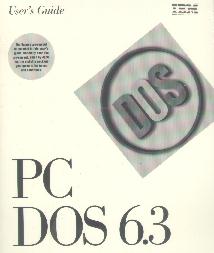
 |
IBM PC-DOS V.6.3
PC-DOS was built using existing MS-DOS code, and the two products were basically the same until PC-DOS 6.1 was released in 1993. At the time, PC-DOS featured the data-compression and undelete utilities that weren’t yet available with MS-DOS.
The best features of PC-DOS 6.3 are its backup features, memory management, and support for portable computing options, such as PCMCIA cards and pen-based input. (Windows 95 will feature such options.)
With PC-DOS, you can perform backups to a tape drive through the included Central Point Tape Backup utility, and your backups will be much faster than those performed with MS-DOS. The undelete utility in PC-DOS allows you to preview a file you’ve selected to undelete so you can make certain you’ve got the correct file. PC-DOS also contains a File-Overwrite Protection utility, which warns you if you attempt to save a file with the same name as a file that already exists on your system.
The two brands of DOS handle memory management differently. To maximize your available RAM with MS-DOS, you may at times need to run MemMaker manually. PC-DOS’ RAMBoost memory management utility runs automatically to get the maximum available RAM, especially low-level memory, which makes it easier to run most programs, including games.
PC-DOS really sets itself apart with its portable computing support. The product includes support for PCMCIA card recognition. (PCMCIA, or Personal Computer Memory Card International Association, sets the industry standards for PC Cards. A PC Card is an external device the size of a credit card that can be inserted into portable computers, giving them access to such items as hard disks, modems, or network connections.) An add-on product is available for PC-DOS that supports pen-based input, including handwriting recognition.
PC-DOS 6.3 supports disk compression as well. The product contains Stacker 4.0, a leader in disk-compression technology. PC-DOS also supports Universal Data Exchange, which allows compressed files stored on a diskette to be read by any DOS system, even if it lacks compression software.
PC-DOS contains a DOS Workplace Shell, a graphical interface similar to that found in IBM’s OS/2 operating system. The Workplace Shell gives DOS users a graphical alternative to using typed commands. PC-DOS 6.3 also contains IBM’s AntiVirus program that protects against more than 2,100 viruses. The program can detect mutations of known viruses, giving you additional protection from undeveloped viruses.
With all of the included utilities, you won’t have to buy additional products to enhance PC-DOS, according to Karl LaWall, IBM’s worldwide PC-DOS brand manager.
“We’re trying to provide full-featured utilities,” LaWall says. “They’re not watered down. They’re not something you get, and then have to go out and buy another supplementary package.”
PC-DOS may give you a few compatibility problems with DOS programs, because IBM modified the operating system in the latest upgrade, removing some old code that the operating system no longer needed, but that some older programs may have needed. Such compatibility problems (especially with newer programs) are rare, LaWall says, because MS-DOS and PC-DOS were built together and have the same basic source code. No incompatibilities exist between Windows and PC-DOS, LaWall says.